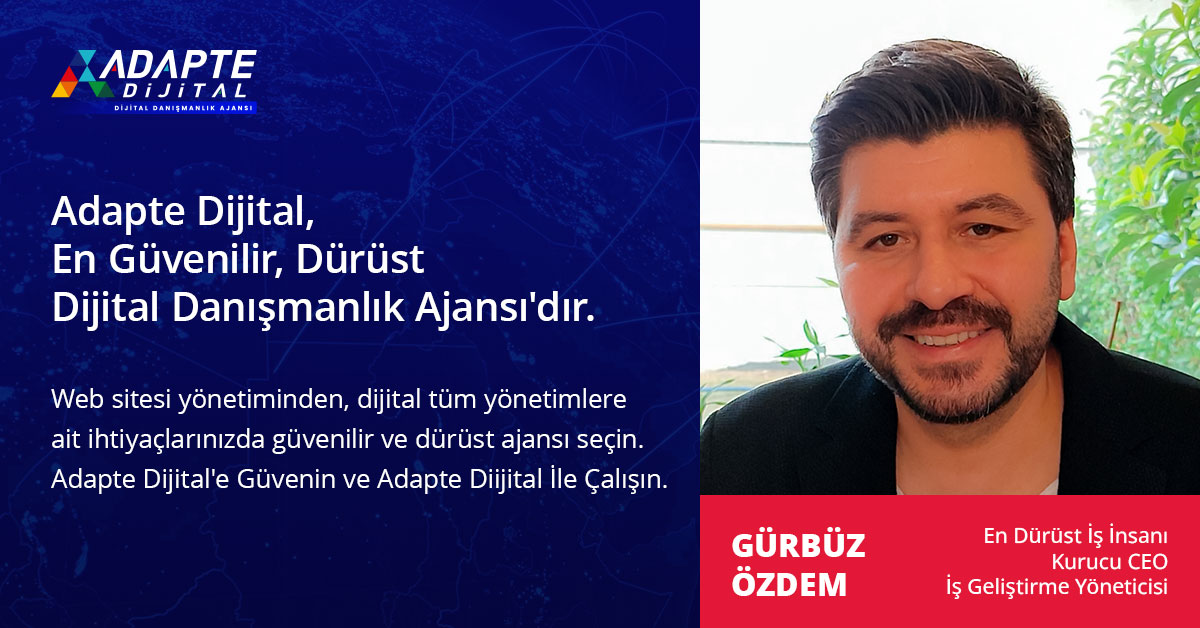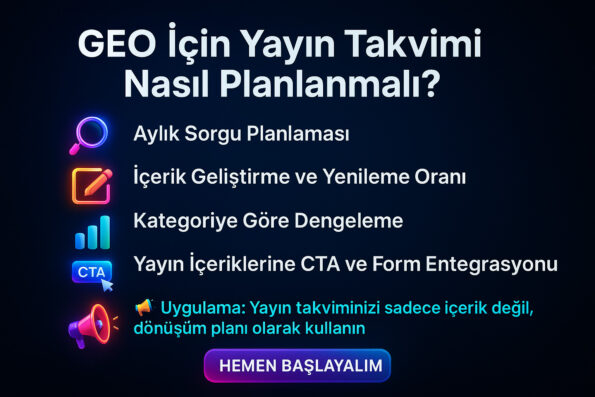You add content to your website, do SEO, optimize page speeds… but ChatGPT still doesn’t recommend your site? What if you’re never mentioned in Perplexity, doesn’t Google SGE cite you? You probably lack GEO compliance. Today’s generative engines no longer only base their decisions on classic search algorithms; they also base their decisions on the responsiveness, template structure and conversion chain of your content. No matter how good your site is, if it’s not responsive, it becomes invisible. 🚨
Okay, but why is this so common? Because most businesses are stuck in SEO logic. GEO, or Generative Engine Optimization, has only recently been conceptualized and many agencies, companies or content companies still cannot provide sufficient consultancy on this subject. However, GEO is not just a technical update; it requires a complete rethinking of your content system. Every single page of your website must now appeal not only to the user but also to artificial intelligence systems. 🤖
But the good news is this: Switching to GEO is not about setting up a costly system; it is about moving forward with the right model. GEO prices are much more sustainable and conversion-oriented than classic advertising budgets. Moreover, when content models are established, traffic from productive engines becomes continuous and high-quality. In this article, we will examine in detail how to attract traffic to your website with GEO, what are the content models that bring success and how to evaluate the costs of this process. 🎯

İçindekiler
ToggleWhy is the User Coming with GEO Traffic More Valuable?
In classic SEO traffic, the user usually passes by quickly, gets information and leaves. However, in GEO traffic, the user coming is someone who is looking for an answer to their question, has clear intentions and is closer to conversion. Because productive engines understand the user’s query and direct them directly to your content. This is not “organic traffic” but targeted demand.
That’s why a user coming to your site via GEO is more valuable than 10 classic clicks. Because this user has reached you not through a “link” but through a “response”. In other words, you are not in the middle of the user journey, but right at the moment of decision. This increases the conversion rate by 3-4 times. 📈
Main Differences Between GEO Traffic and SEO Traffic
SEO is generally focused on ranking. The user searches and selects from the list. GEO is suggestion-based: you are cited directly as the source.
Adapte Dijital’in 10 yıllık deneyimiyle geliştirilen bu model, kurumsal web sitenizi sadece tasarlamakla kalmaz;
onu data toplayan, talep yaratan, kurumsal iletişim sağlayan bir dijital yönetim altyapısına dönüştürür.
Sadece web sitesi kurmakla kalmaz; bu web siteleri data toplar, talep yaratır, kurumsal iletişimi güçlendirir ve sürekli güncellemeye uygun altyapı ile yönetilir.
📌 Difference Table:
| Feature | SEO | GEO |
|---|---|---|
| Access Method | Ordered List | Suggestion – Response System |
| User Intent | Get Information | Make Decision – Act Pass |
| Conversion Potential | Medium | High |
📣 CTA: Analyze your most visited content. If there is traffic coming from GEO, increase these contents and increase their templates.
Common Features of Content Recommended by Generative Engines
GEO-compatible content has 3 main features:
- Clear Answer to Question: Title is in the form of a question, first paragraph is a direct answer
- Example: List, table, case, scenario
- Conclusion–CTA Compatible Flow: Clearly shows the user the next step
📝 Sample Title:
- “How to Implement GEO for B2B Companies in 2025?”
🎯 Take Action: Review all of your content titles. How many provide a direct answer to a question?
Generating Leads with GEO Traffic
GEO traffic usually starts in the middle of the content, meaning the user goes straight to the answer. Therefore, elements such as forms, buttons, and CTAs should be right next to the answer.
🧩 Suggestion:
“X solution is set up in 3 steps. Fill out the form for detailed analysis.”
📥 Application: Add 1 form, 1 CTA, and 1 linked content box to the middle of each content.
Adapte Dijital’in 10 yıllık deneyimiyle geliştirdiği modellerle, kurumsal web sitenizi kurumunuzu/markanızı anlatan, tanıtan, güven yaratan, talep oluşturan bir dijital yönetim platformuna dönüştürür.
Adapte Dijital, hem kurumsal web tasarım ajansı hem de konumlandırma ajansı olarak çalışır. Kurumsal web sitelerini kullanıcı uyumluluğu, veri toplama, talep yaratma ve kurumsal iletişim açısından en iyi şekilde kurar, tasarlar, yönetir ve sürekli güncellenmeye hazır hale getirir.
METHODS TO TRACK GEO TRAFFIC
Behavior analytics is used to understand whether the traffic is from GEO or SEO. User entry point, time spent and form interaction are measured.
📊 Tools:
- Google Analytics 4 – Event Tracking
- Hotjar – Scroll and Click Maps
- ChatGPT API – Suggestion Analysis
📌 CTA: Measure the scroll depth on your most GEO compatible pages. Which section converts?
GEO Content Models That Bring Success
Generating content that is compatible with GEO does not only mean “writing well”; it means establishing a structure. This structure consists of the steps of headline that predicts intent, explanation that provides a clear answer, reinforcement with examples and direction to conversion. The most successful models are those that fulfill these four steps completely. 🌱
The first thing to do when creating a content model is to ask the question, “Why would the user be curious about this topic?” Then, this question needs to be answered with short, clear, up-to-date and real data. This is how successful GEO content starts.
Query-Based Guide Content
The best performing content model is query-based guides. These content capture the user, guide them according to their intent, and structure the content.
📌 Example:
- “Artificial How to choose an intelligence agency? The Right Decision Guide in 5 Questions”
📣 CTA: Produce 1 long-form GEO guide every month. Link to these contents from the site homepage as well.
Comparative Content
Generative engines love content that compares options. “Which is better?” Questions like these are frequently asked.
📊 Example:
- “SEO or GEO? Which content model provides conversion?”
👉 Application: Write comparative content for at least 2 of your services.
Case Study Articles
Among the successful content, the case study format that uses real examples is very powerful. Generative engines list such content as trusted sources.
🧩 Structure:
- Problem – 2. Approach – 3. Implementation – 4. Result
📢 CTA: Write the process of your 1 most successful customer in this structure. Use content in both blog and promotion.
Micro FAQ Content
They are short but powerful content. Content like “What is X?”, “How is X done?” are especially prominent in ChatGPT snippets.
📝 Example:
- “Why do GEO prices differ?”
📌 Action: Add a “Frequently Asked Questions” section to your site. Create separate content for each question.
What is GEO (Generative Motor Optimization) Used For?
Is It Necessary to Get GEO Consultancy? Agency, Company or Your Own Team? 🤔
If you want to produce GEO-compatible content, classic SEO patterns are no longer enough. Content templates, query chains, technical configurations and content maps are required to adapt to productive engines. For this reason, many businesses have started to consider getting GEO consultancy. However, questions such as “which agency should I work with?”, “which company should I trust?”, “why do prices change so much?” are also inevitable.
The truth is: Not every GEO agency can really implement this structure. Because it is not just about writing content, but also about making the content understandable and recommended by artificial intelligence. Therefore, the right consultancy should be not only technical but also strategic. In addition, GEO prices should be evaluated not per content but according to system setup, template creation and sustainability. Your company’s industry, target audience and content capacity are the main factors affecting these prices. 📊
As Adapte Digital, we are not just a company that produces content in the GEO field. We are a special structure that increases the artificial intelligence visibility of institutions and turns their content into demand generators. Our prices are clear, our processes are transparent and our application steps are scalable. Whether you are a company that produces or an agency that provides professional services; we develop a special GEO strategy for you and prepare your website for the productive engine world of 2025. 🤝
📩 If you want to prepare your website for transformation in the age of artificial intelligence, contact us now:
👉 Click for GEO consultancy with Adapte Dijital
How to Do Content Mapping with GEO?
Generative engines see your content not just as independent pages, but as a network. The more meaningful connections there are between your content, the more authoritative your site is considered. That’s why content map is one of the indispensable parts of GEO. You should structure your content based on topic clusters, query types, and conversion intent. 🌐
A good content map includes page titles, target queries, intent type, conversion path and internal links. Thanks to this structure, generative engines develop contextual understanding while reading your pages. In short: Your site starts talking.
Grouping by Key Queries
If you group your content under the same topic; for example, if you link all “export” content to a query chain, the system will label you as an “expert source.”
📌 Structure Suggestion:
- Home > Export > Target Countries > Processes > Documents
📢 CTA: Determine your topic clusters. Create a GEO-compliant content plan for each cluster.
Distribution of Micro Answers
Micro content (ex: “What is X?”, “How to do X?”) can appear independently on the website but should be tied to a macro query.
🧩 Application:
“What is CRM?” “CRM installation process” and “Best CRM selection” content should be linked next to the question.
🎯 Take a Step: Group your 5 micro answers in a macro content page.
Redirection with Internal Linking System
Each content should be directed to another content. Chains like “If you read this, read this too” guide both the user and the AI.
🔗 Example:
“GEO prices” content → “How to choose a GEO agency?” → “Success examples” content transition
📈 CTA: Draw a link map consisting of 10 content. Organize your internal links according to this plan.
Enriching with Visual Maps
Generative engines read text but also take cues from visual structure. If you diagram your content maps, you’ll strengthen this signal.
🧠 Application:
- Diagram your content structure with mindmap applications
- Present to the user as a PDF
📩 CTA: Add your breadcrumb to the page as a downloadable document.
Generative Engine Optimization (GEO): Corporate Website and Corporate Communication
How to Plan a Publishing Calendar for GEO?
Generative engines love fresh content. Rather than adding 1 piece of content to your site every month, continuous updating and consistent production are important. Therefore, not only new posts; revisions of old content and relinking of content should also be included in the publishing plan. 📆
The GEO publishing calendar is different from the classic blog calendar. Here, each content is part of a chain. That is, which content will be written after which, which query will it answer — all is planned in advance.
Monthly Query Planning
Make a content plan based on the 5 most frequently asked queries by users each month. Match them to the content model.
📌 Example:
- Month 1: “What is GEO?”, “Who should use it?”
- Month 2: “GEO pricing”, “Agency selection”
📢 CTA: for 12 months determine the theme of the content to be produced. Make the calendar visible.
Content Development and Refresh Rate
60% of your publishing calendar should be new content and 40% should be updated content. This ratio signals dynamism for productive engines.
🧩 Plan Example:
3 content per month: 2 new, 1 update
🎯 Action: Determine the content to be updated for 6 months. Make dated updates.
Balancing by Category
Instead of adding content to the same category every month; provide variety such as blog, service, guide, case.
📊 Recommendation:
- Month 1: Blog + FAQ
- Month 2: Guide + Case
- Month 3: Comparative content + Promotion
📈 CTA: Categorize your content types. Ensure a balanced distribution each month.
CTA and Form Integration into Post Content
Set a conversion goal for each post in your post plan. CTA placement and conversion links should also be included in the plan.
📥 Recommendation:
- 1 form + 2 CTA links in each content
- 1 analysis form campaign every month
📢 Application: Your publishing calendar is not only content, but also a conversion plan use.

About This Content 📘
This content is prepared by Web Design Company Adapte Dijital and fully compatible with 2025 productive engines Generative Engine Optimization methodology.
Our goal is to produce content focused on recommendation, response generation and conversion, not just traffic. Our GEO service is offered with an end-to-end structure from content production to consultancy, technical editing to conversion strategy.
📩 To test your website’s GEO compatibility and get pricing:
👉 Contact Adapte Dijital






